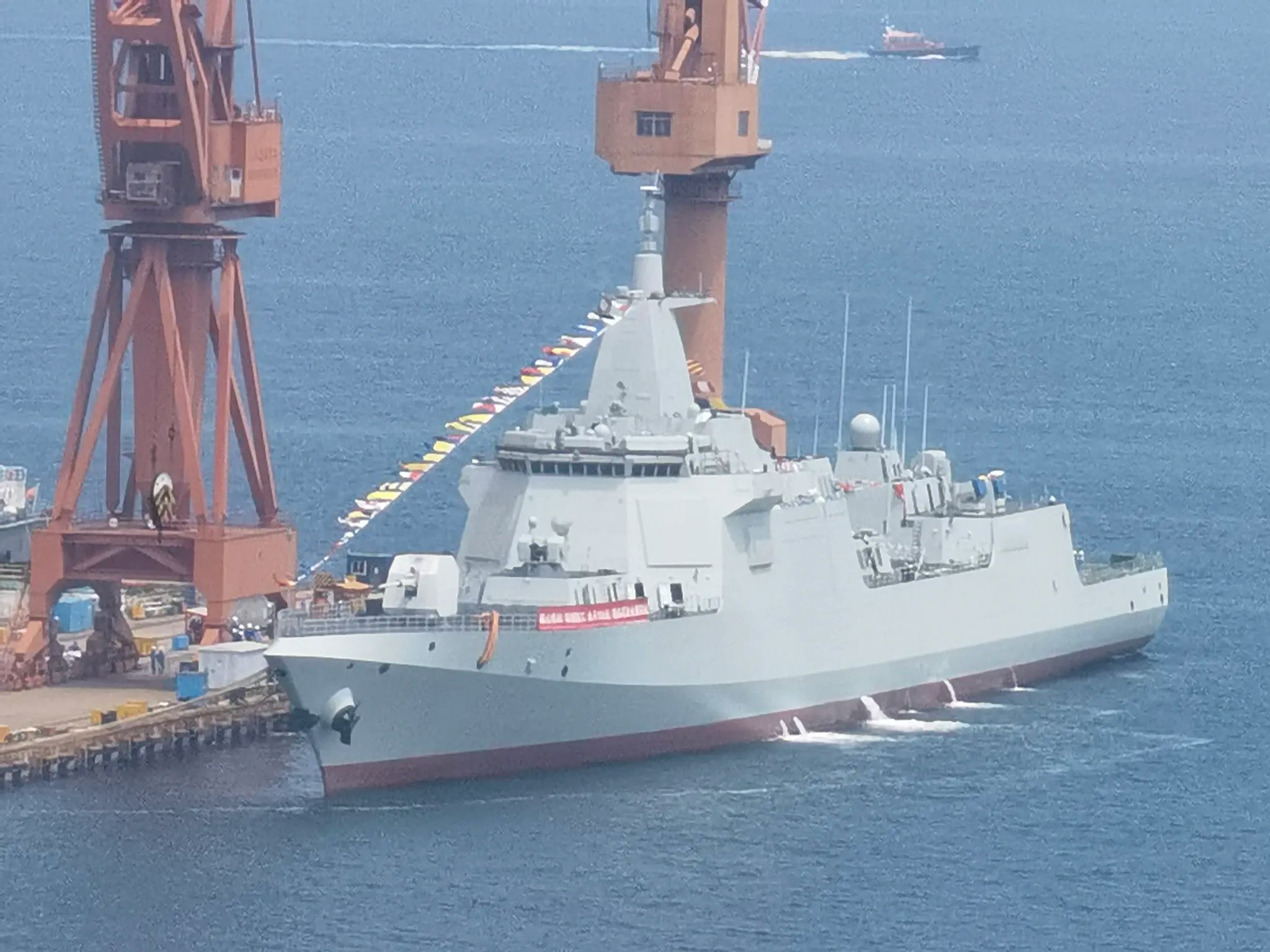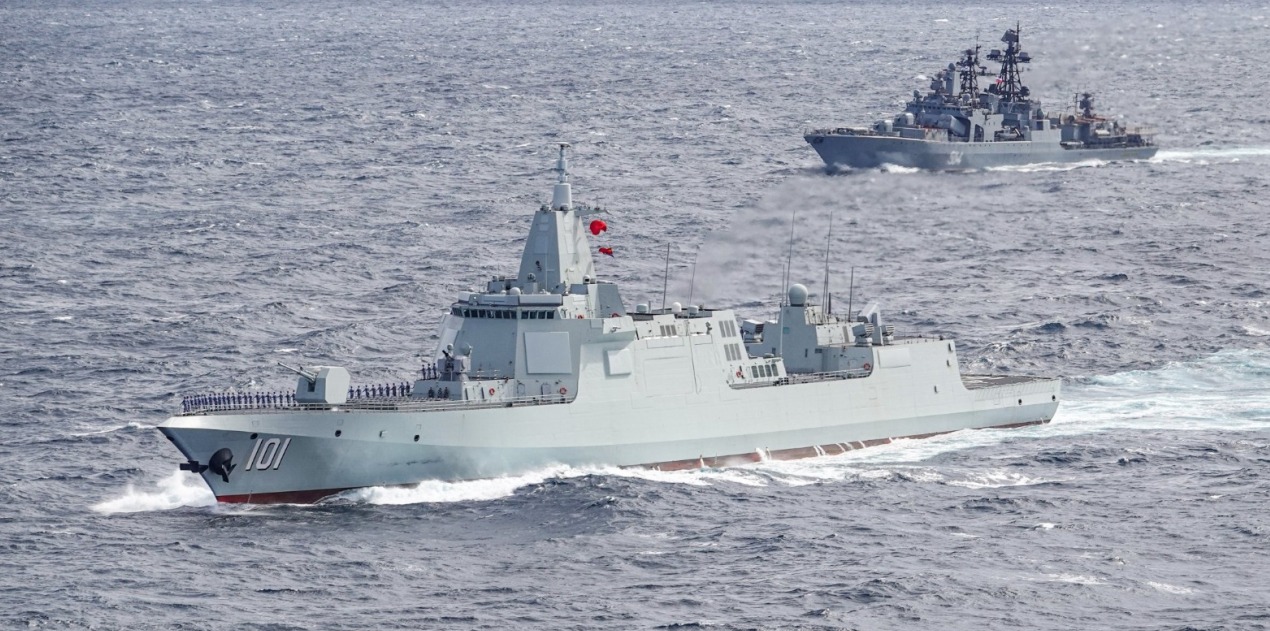With China and the Philippines frequently confronting each other over territorial disputes, the Chinese People’s Liberation Army (PLA) Navy announced that the eighth Type-055 large destroyer had reached operational capability during a recent exercise in the contested South China Sea.
With the last of the class achieving operational capability, all eight warships in this class that are currently in service are now prepared for deployment, experts told Chinese state publication Global Times.
China Central Television (CCTV) carried a broadcast last week announcing that the Type 055 large destroyers Xianyang and Yan’an, which are part of the PLA Southern Theater Command’s navy, went on a combat readiness training mission in an undisclosed location of the South China Sea during the Spring Festival holidays.
The eighth and most recent Type 055 heavy destroyer of the PLA Navy, the Xianyang, was commissioned last summer. In the latest drills, the Yan’an executed simulated missile attacks on suspected marine targets, and the Xianyang was assigned to independently counter mock aerial targets.
“When I first saw the Xianyang, it was just an empty shell in the shipyard. I have witnessed with my own eyes its delivery, tests, trials, and commissioning. Now, after the full-course training program over the past year, we have achieved operational capability,” Chen Fashun, a crew member on the Xianyang, said in the CCTV report.
Finally some shots of 8th Type 055 Destroyer 'Xianyang' (108) , the final Warship of the initial planned 8
'Yan'an' (106) also in the clippic.twitter.com/x62duNCPqE
— Húrin (@Hurin92) April 21, 2023
The Xianyang Type 055 vessel debuted on state television on April 21, 2023, to commemorate the Chinese Navy’s 74th anniversary. All eight of these ships are part of the People’s Liberation Army Navy’s Northern and Southern Commands. The primary purpose of the Type 055 destroyers is to give the Shandong (CV-17) and Liaoning (CV-16) Chinese carriers a strong capacity for area air defense.
The development comes during mounting tensions in the South China Sea between China and the Philippines. For instance, the Philippine Coast Guard accused China Coast Guard (CCG) ships of engaging in “dangerous” maneuvers over the weekend.
The Philippines announces that China has started using cyanide fishing to ‘intentionally destroy’ the Scarborough Shoal fishing grounds for Filipino fishermen.
The shoal belongs to the Philippines according to international law but China claims it as its own.
🇵🇭🇨🇳 pic.twitter.com/b2epGSCE7H
— Visegrád 24 (@visegrad24) February 18, 2024
Following that, tensions erupted in another disputed territory: the Scarborough Shoal. China accused the Philippines of carrying out unwarranted provocations by “illegally entering the waters of Huangyan Island (China’s name for the shoal)” on the last day of the Chinese New Year holiday. On its part, Manila accused Beijing of using cyanide to destroy the Scarborough Shoal, which also remains contested between the two countries.
There have been frequent stand-offs between Chinese and Philippines vessels in recent months, with both sides asserting their territorial claims and trading barbs. Manila has taken some decisive steps, like announcing the expansion of its presence in Batanes Island, which overlooks Taiwan, and deploying a warship off the waters of Palawan island facing the South China Sea to “protect its maritime interests.”
Against that backdrop, the Chinese military announced earlier this month that it was conducting routine naval and air forces patrols in the South China Sea ahead of the Lunar New Year Eve holidays. “Troops in the theatre remain on high alert at all times and will resolutely defend national sovereignty, security, and maritime rights and interests,” the statement said.

The announcement about the latest drills and Xianyang becoming operational is significant. The Type 055s can also serve as flagships for surface action groups when operating outside of carrier groups, acting as command and control centers of other destroyers and frigates. This essentially means that the Type-055 destroyers are likely to be used by the Chinese PLAN to project power.
The PLA Navy’s first powerful destroyer, the Type 055 ‘Nanchang’ was recognized as a “role model” on January 8 by the Chinese Communist Party committee of the PLA Navy after it completed several challenging missions, including combat drills in which it was tasked with fending off mock attacks by foreign forces. The United States has formally acknowledged the combat prowess of the vessel and the challenge it poses to the US Navy on multiple occasions.
Type 055 Vessels: A Force to Reckon With?
With a displacement of over 12,000 tons, the Type 055 is regarded by analysts, citing publicly available information, as one of the most potent classes of multirole warships in the world as it can host air defense, anti-ship, anti-submarine, and land attack missiles.
Additionally, praises have also been heaped over the exceptional situational awareness provided by its advanced radars, sensors, and data link systems integrated into its mast.
Large destroyers of Type 055 are capable of leading a group of warships in far-sea operations or escorting aircraft carriers. Chinese analysts contend these warships will be crucial in defending China’s interests in development, security, sovereignty, and territorial integrity.
A report published in CNN, which cautioned against a burgeoning Chinese naval power and ship-building capacity, also noted, “But it’s not just the increasing vastness of the Chinese navy that has raised concerns. Some of the ships China is churning out arguably have greater firepower than some of their US counterparts.”

Type-055 was cited as an example to back up the argument and highlight the genuine threat that the vessel poses to the United States and its allies, who remain on a collision course with China. “Take China’s Type 055, in many eyes, the world’s premier destroyer,” the report exclaimed.
China started producing the Type-055 in 2014, and the Xianyang, its eighth, was put into service last year, all in less than ten years. The US, in contrast, has been building Zumwalt-class destroyers far more slowly: only two of them have gone into service five years after construction started.
In comparison to the destroyers of the preceding generation, the Type-055 large destroyer is a massive platform that can carry a lot of equipment and remain at sea for extended periods. It is larger than conventional destroyers with a displacement of 12,000 to 13,000 tons and comparable in size to the Ticonderoga class of cruisers of the US Navy. Additionally, compared to the US Navy’s AEGIS cruisers, they are about a quarter more significant in size.
With 112 vertical launch system (VLS) cells, it has greater surface-to-air and anti-ship missile firing capacity than the US Navy’s newest destroyer, the Arleigh Burke class, which has 96. It also boasts sophisticated anti-submarine and radio armament.
The Chinese warship is believed to be capable of firing at least HQ-16 and HQ-9 surface-to-air missiles, the YJ-18 and CJ-10 families of land-attack and anti-ship cruise missiles, the Yu-8 rocket-assisted torpedo, and the YJ-83 anti-ship cruise missile.
Adding to US concerns, Chinese observers speculate that China could likely build and commission more Type 055 destroyers.
India Shows China Its Maritime Ambitions
What does Chinese muscle-flexing mean to India?
India wants to establish itself as a global power with growing maritime ambitions. The deployment of three guided missile destroyers and reconnaissance aircraft to counter the Yemen-based Houthi rebels disrupting ships in the key Red Sea trading route could be regarded as a veiled message to China.
AP quoted former Vice Admiral Anil Kumar Chawla, who was head of India’s southern naval command, saying, “We are not doing it only out of altruism. Unless you are a maritime power, you can never aspire to be a global power.” India was positioning itself “as a global player today, an upcoming global power,” he said.
Chawla went on to say: “It is a message to China that, look, we can deploy such a large force here (the Red Sea). This is our backyard. Though we don’t own it, we are probably the most capable and responsible resident naval power,” Chawla said.
- Contact the author at sakshi.tiwari (at) gmail (dot) com
- Follow EurAsian Times on Google News




